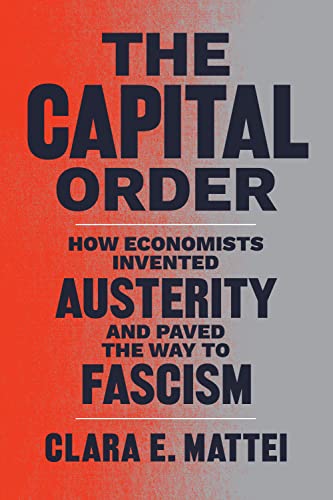published in Issue Three

(University of Chicago Press, 2022)
Generals fight the last war; economists forget it.

Austerity today refers to a mix of deflationary policies that public officials, economists, and members of the financial establishment prescribe when a country’s prices and wages rise more swiftly than they deem acceptable, or when a government’s budget and what is loosely called its balance of payments swing into deficit. It has often served as the go-to policy when inflation surges at home, when a national currency falls with respect to other benchmark currencies, or when the interest rate on its public debt shoots up as compared, say, to « safer » foreign bonds (such as, nowadays, German long-term bunds). Austerity can be prescribed by the authorities of a currency union if a member threatens to default on its debt; recall Greece’s plight a decade ago. Austerity policies can cause great suffering, sometimes short-term but often prolonged, and the misery can fall on social groups who had little responsibility for the inflationary surges. Consider Argentina’s repeated cycles of urban wage increases enacted under Peronista governments and then the vast rural misery attendant upon its subsequent stabilization programs. Austerity often represents a highly moralized policy prescription. It is a call to repent for alleged high living, national loafing, and frivolous spending. A sarcastic Mephistopheles prefigures the message in Goethe’s Faust: « You must forego, must do without — that’s their song all the time. »
Imposing austerity requires a tried-and-true repertory of policies, including cutting government spending and raising central bank interest rates to curb borrowing and make home mortgages and credit card purchases more expensive. The same policy supposedly makes it more attractive for foreigners to buy a country’s commodities and manufactures, to buy its bonds or real estate, and to speculate on a rebound in the value of its currency. Austerity’s defenders claim that any adverse impact on employment will quickly end and will be justified by eventual success. Such is the theory. Clara Mattei will have none of it. Her vigorously written and well-researched new study, The Capital Order: How Economists invented Austerity and Paved the Way to Fascism, insists that austerity is a class strategy, not just a policy to restore economic equilibrium: « Austerity is a political project arising out of the need to preserve capitalist class relations of domination. It is the outcome of collective action to foreclose any alternatives to capitalism. » Her focus falls on Italy and Britain between the wars. As she insists at many instances in her account, « Austerity was, and remains, an elaborate exercise in class domination. »

This is a strong statement. The impact of austerity is easier to demonstrate than the intention. Of course the major sacrifice is usually borne not by those who prescribe it but by the far less affluent. Those who call for « belt-tightening », to use an old metaphor, are reaching for other people’s belts already drawn far tighter than their own. Austerity may entail deferring executive bonuses and delayed corporate mergers, and it has led to some retrenchment in the bloated financial industry, but its major bite is on employment and government social programs. Its advocates take it for granted that those who are laid off will be reabsorbed into more productive jobs. Often in the Third World it is in casual labor; in the United States, where I am writing, many go on to work at Amazon or Walmart. In any case, austerity usually means freezing or rolling back the aggregate share of national income that flows to the working classes. It is a one-sided remedy, justified by the supposed danger to the national economy that sustains us all.
The policy package of cutting welfare budgets and unemployment benefits while raising interest-rates was christened as « austerity » only recently. Earlier fiscal hawks certainly urged cutting expenses, balancing the budget, making exports cheaper, and encouraging the wealthier classes to save by cutting their taxes. But they didn’t call their policies « austerity », and the word often referred just to economic stringency or sacrifice, as it did during Britain’s prolonged post-World War II years of rationing and restrained private consumption, which Clement Attlee’s Labour government maintained in an effort to make their ambitious welfare policies feasible. The « subprime » US economic crisis and its global ramifications brought the concept back into the limelight under its current name, and in 2010, Merriam-Webster’s named austerity the word of the year. Three years later the British economist Mark Blyth’s Austerity: The History of a Dangerous Idea judged austerity an « unmitigated disaster for
What triggers the austerity reflex? In the euro crisis of 2009-2012 it was the fear that Greece might default on its debts, held largely by German banks, and that that default would then ripple through other indebted economies, preeminently Italy and Spain — in short the specter of a massive write-off of assets. As of late 2022 and early 2023, it has been the widespread rapid rise of prices — whether from four percent to twelve percent in the United States or from 30 to 70 percent in Turkey, where President Erdogan has insisted on flouting the austerity prescriptions that western experts and perhaps simple common sense might recommend. Internal price rises and balance-of-payments crises often go together; modern economies cannot be shielded from international competition and currency speculation, or from geopolitical shockwaves such as the Russian tightening of oil supplies in retaliation for Western support for Ukraine.

How much inflation is too much? — when, that is, does a rate of general price increases become unacceptable? Until the beginning of 2023, policy makers and economic commentators seemed more preoccupied by the problem of too little inflation, which threatened to dampen economic activity, although Japan has lived with imperceptible inflation for decades. Although it is hard already to recall, until the direct payments that Americans received under the American Rescue Plan in early 2021, deflation seemed the greater threat.
Contemporary economists and policy makers prefer a modest steady rate of inflation to a steady state of prices. A steady-state economy, even a prosperous one, also seems unacceptable: neither left nor right challenge the preoccupation with economic growth. But economic growth as such only became a governing objective in the 1940s and 1950s. It was an index dictated by concern with international competition, above all with the Soviets, as well as with domestic welfare. Growth and inflation are by definition rates of change, and the tacit assumption has been that economic growth requires a modicum of inflation. But there is no inscribed ideal: a rate of inflation is not like the human body temperature where our metabolism maintains a constant, « normal » 37C or 98.6F. Central bank officials, until recently, talked as if a two-percent rate was the goldilocks rate: enough to keep activity humming and growth increasing, to make the cost of borrowing money for investment acceptable, but not enough to skew incentives into unproductive financial speculation. Just right.
The difficulty is that it is hard to stabilize any given rate of inflation; and societies feel the pain of a rapid rate. Dramatic inflations have punctuated twentieth-century political history. Today, economists and politicians look back at the double-digit inflations running from the late 1960s to the end of the 1970s, and associated with labor unrest and the OPEC price increases, as the horror scenario to be avoided. But the twenty-percent rates of the late 1970s were nowhere near the astronomical rates of inflation incurred by countries in the wake of the two world wars, when no one wanted to hold the depreciating money of the defeated powers. In 1924, the German Mark was painfully converted into a new Reichsmark at the effective rate of a trillion to one; after World War II the Hungarian pengo bottomed out at a quintillionth of its value; Chinese money became worthless during the civil war. In effect money died; these societies quoted prices in terms of dollars or pounds; the trading of heirlooms and services and even American cigarettes replaced monetary transactions. These hyperinflations produced popular unrest and despair, but it is not easy to pinpoint their contribution to political alienation and protest.
As Mattei suggests, the process of ending inflation can be as politically painful as that of inflation itself. The Nazis’ political successes were long attributed to inflation although in fact it ended nine years before they came to power. Just as powerful a source of electoral resentment and subsequent Nazi successes was the mid-1920s stabilization that revealed the worthlessness of bank accounts or insurance policies and exacerbated liberal party fragmentation. In 1989, with the fall of the Berlin Wall, Chancellor Kohl’s West German government decided it could not afford to run a similar risk of East German alienation at unification and propped up bank accounts and salaries in the East. But this policy incurred the opposite problems of revealing East German enterprises as uncompetitive relics, having to subsidize many make-work schemes, and still forcing many into premature unemployment. Meanwhile, by the late 1990s, post-communist Russia, emerging markets such as Thailand, and Latin American countries governed by the left, were trying to cope with disastrous currency depreciation.
How do societies deal with rates of inflation that seem too high? — or, more precisely, that cannot be kept constant but tend to accelerate? One choice is to try and increase family income pari passu by indexation. American pensioners see their social security payments raised each year by the previous year’s increase in the consumer price index. Societies have tried indexation schemes for wages — in Austria after World War I, in Italy after World War II until the early 1980s, also in Israel into the 1980s. The difficulty with indexation is that it greases the wheels of inflation in turn; it makes further inflation seem to have fewer consequences in terms of purchasing power and thus easier to accept.
The other answer is the one Mattei condemns: austerity. Mattei follows two early twentieth-century episodes in England and Italy after World War I which helped set the pattern and produced the rhetoric that has usually accompanied the policies. By selecting Britain, which maintained a liberal political system, and Italy, which succumbed to authoritarianism, she intends to demonstrate that the logic and dictates of austerity policies underlay both experiences.
At the origin of both lay the social and financial impact of World War I. Throughout Western Europe, demands for military production had subjected labor to extraordinary factory discipline, but also enhanced its collective power and activism. The aftermath of the war and the Bolshevik Revolution in Russia brought waves of labor unrest, even in the countries that had been victorious, such as Italy, France, and Britain. Mattei stresses the fright that mass strikes and workers’ councils produced among the upper and middle classes in these countries, as well as in defeated Germany, Austria, and Hungary, where revolutions swept away the respective imperial regimes (as had occurred in exhausted Russia a year earlier). In Britain, she notes, « successful national bargaining with the state gave basis to the miners’ audacious program. » The government convened the Sankey Committee to hear the miners’ grievances. Against historians who have judged the Committee to be a tactic to defuse radical demands, Mattei argues that the workers’ « challenge to the pillars of capitalism had entered the foyer of the capitalist fortress. » She celebrates British demands for workers’ control and Italian factory councils’ brief takeovers as heralding a democratization of production relations as well as ownership: « political imagination toward the abolition of private property and wage relations moved from abstraction to reality, » she writes, and « the efforts of these rank-and-file workers took on a clear-cut revolutionary form in opposition to both capital accumulation and the state — and pushed capitalism to the brink. » In Italy, Mattei waxes enthusiastic along the lines of the then-young Antonio Gramsci, who envisaged the Turin factory councils — the counterpart to the Russian « Soviets » — as the nucleus of social revolution. But, different from Russia, northern Italy had a dense and developed urban middle class, and the landlords of the South also remained secure. In his later notebooks, written during his decade in a fascist prison, Gramsci reassessed the continuing hold of this « hegemonic bloc » and the weakness of revolutionary challengers.
The financial aftermath of the First World War was potentially just as destabilizing as the increase in labor’s power. The belligerent countries had devoted from thirty to about fifty percent of their national output to the war effort, but they all resisted a sudden imposition of the tax increases necessary to cover these vast expenses, instead relying largely on their compliant central banks to print the funds needed. Financing war thus produced a large monetary expansion with a powerful potential for price inflation once price controls were relaxed. Outside Britain — which imposed the austerity policies that Mattei laments — European countries were too divided politically in the early postwar years, and their regimes too precarious, to rein in the inflationary expedients.

In her account, the Brussels conference of 1920 and the Genoa Conference of 1922, ostensibly devoted to postwar economic reconstruction, confirmed an international commitment to central bank independence, thus providing a bulwark against democratic economic management. But labor’s demands for wage hikes to meet ongoing price increases likewise had to be curbed. Only by humbling militant trade unions could economic managers and government officials restore tolerable conditions for ongoing capitalist — to use the accepted term of Marxian analysis — « accumulation. » She takes up an argument made notably by the Hungarian-born British economist Mikhail Kalecky in 1943, namely that capitalists must curb full employment lest it allow workers too much leverage in the labor market.
Historians of Europe are familiar with this postwar social and economic ferment. Arno J. Mayer told the story from the perspective of the Left in his 1967 magnum opus, Politics of Peacemaking: Containment and Counterrevolution at Versailles, 1918-1919. This reviewer wrote his dissertation and first book, Recasting Bourgeois Europe (1975) almost fifty years ago on the cycle of radicalism, reaction and stabilization that marked German, French and Italian history in the postwar decade. Most of Western and Central Europe followed the same historical rhythm. Much hoped-for change foundered on the shoals of austerity: not only the radical shop-steward agitation, but the reforms championed by the British parliamentary Left, in particular the aspiration to clear slums and provide « homes for heroes ».
Mattei’s contribution is to reveal how the influential economic advisers at the British Treasury and Bank of England (supposedly independent but representing the same civil-service elite) helped dismantle the left’s programs. She refers to them as « technocratic » advisers; in fact, compared with today’s supposed technocrats, such as Mario Draghi, they were highly partisan actors, claiming the mantle of scientific expertise as they called for cuts in public spending. Ralph Hawtrey, Otto Niemeyer, and Basil Blackett rotated from the Treasury to the Bank of England and then became members of the League of Nations financial committee, where they joined missions to « rescue » first the Austrian, then the Polish, Bulgarian, and Greek currencies. Mattei stresses the class-based moralism of these reformers: Hawtrey, on the morrow of the First World War, lamented the expansion of « effective demand » as representing an excess of purchasing power « swollen under war conditions » It led, he argued, to « too much buying » and would depress the value of sterling. (Keynes later deployed the term differently in his 1936 General Theory of Employment, Interest and Money; his « effective demand » was a motor of full employment, signifying society’s aggregate desired consumption of goods and services.)
Because Mattei focuses on Italy alongside Britain, she stresses the links between austerity policies and fascism, claiming, in the words of her title, that economists « invented austerity and paved the way to fascism. » If « paving the way » means contributing to the success of fascism, this claim seems tendentious. After all, Britain imposed austerity policies in the late 1920s and early 1930s, as well as in the early 1920s, without resorting to fascism — and it even did so with the acquiescence of the Labour Party. One could argue instead that fascism — the term used here generically for rightwing and nationalist dictatorship — or military take-over became a strategy when a ruling class could not impose austerity: recall the military takeovers in Brazil in 1964 and Argentina in 1966 and again in 1976.
After World War II in Europe, fascists mobilized, as her narrative shows, against a militant working class that was challenging the hierarchies and discipline of bourgeois labor relations. The rhetoric of fascism was not couched in terms of national accounts; it claimed to draw on the vitality engendered by combat and war. Once Italy’s fascists had the power to do so, they embraced monetary orthodoxy (the doctrine of the laissez-faire liberisti) as part of their package, but they soon focused on authoritarian restructuring of the labor market. The most influential orthodox Italian economist, Maffeo Pantaleoni, whom Mattei cites as a counterpart to Hawtrey or Niemeyer, had a visceral hostility to unions, but his rage was kindled by their organizational offensive as much as by budgetary concerns. When agrarian socialists sought to organize before World War I, he fumed that the sentimental women who supported them should all be electrocuted — the high-tech method of execution that America was pioneering. Pantaleoni, who remained outside fascist ranks, apparently had to brief the new rulers on economic doctrines. The economic historian Alexander Gerschenkron recalled to me years ago that Pantaleoni had told him that he’d « sweated through two black shirts » (Ho sudato due camicie nere) to explain marginal theory to the Duce.

Mattei rightly argues that once safely in power the fascists pursued a ruthless deflationary program, drastically reducing social welfare expenses, an expedient still possible in a society where family and church played a large role in coping with economic misery. Once meaningful trade union activity was suppressed, the government could even impose successive across-the-board wage cuts. The regime also intervened to refloat bankrupt industries, culminating with the creation of the Institute for Industrial Reconstruction (IRI), a state holding company that took over almost half of heavy industry’s shares during the depression. Mattei sees both bailouts and austerity « as a lever of power for society’s upper crust … and the go-to policy intervention for governments dealing with financial crises today. » True enough, but these measures are not necessarily or exclusively fascist.
By the mid 1920s, both Britain and Italy sought to crown their deflationary policies with revaluations of their national currencies at unjustifiably strong exchange rates. The economic historian Barry Eichengreen has told this story in Golden Fetters: The Gold Standard and the Great Depression, 1919-1939 (1996). During and immediately after the war, Western countries had suspended « convertibility » (the right to convert their currencies into gold or other moneys), but orthodox economics required that exchange rates expressed in gold equivalents be restored when possible. The 1922 Genoa Conference established dollars alongside gold as a recognized reserve asset but, as Mattei emphasizes, otherwise reaffirmed this goal. The exchange rate at which convertibility was to be restored remained an open issue. British financial spokespersons and treasury officials argued that a strong pound that restored prewar exchange parity with the dollar was needed to preserve London’s role as the preeminent center for international banking. A reduced pound would be a breach of faith, and foreign depositors would not park their surpluses in London if their value was to be partially expropriated. British prices, however, had risen proportionally more than American prices and thus handicapped UK exports on the world market. Just as debilitating were the relatively high interest rates needed to sustain the strong sterling exchange rate, which inhibited domestic investment, whether in housing or industry, and saddled the country with a chronic unemployment rate of around ten percent, even during the relatively prosperous years of the late 1920s. Keynes, in 1925, did not take a strong stance against restoration of the pound to gold; the then-chancellor of the Exchequer Winston Churchill swallowed his doubts. The Tories, in short, with little dissent from Labour, fell on the sword of strong sterling in 1925. The two parties in coalition were compelled to devalue in 1931, and Labour had to preside over postwar devaluations in 1949 and

Mussolini decided Italy must follow suit. American financiers, prominent among them Thomas Lamont of the Morgan bank, helped to raise American loans as foreign purchasers over looked the actions of an ever more authoritarian regime. The Quota Novanta (the restoration of an exchange rate at 90 lire per British pound) was accompanied by the effort to cut imports and become self-sufficient in wheat (Mussolini’s Battaglia del grano), a policy that helped entrench the power of landlords and preserve the stagnant hierarchies of the South. In 1929, the Lateran Pact with the Church would cement the apparent fusion of old elites and the fascist party. The United States tried a mix of policies when the Stock Market crashed in 1929, and the relative boom of the late 1920s collapsed, among them devaluing the dollar by 25 percent in gold terms. The French stabilized between 1926 and 1928 at a rate that recognized how much inflation had cut into their national savings; their economy subsequently hummed and they accumulated gold until finally the depression caught up with them, too, and the franc had to be devalued anew in the late 1930s. The left had remained too strong for austerity to prevail, but never strong enough to leave capitalism behind.
As Mattei makes clear in her final chapter, « Austerity Forever », these deflationary monetary interventions were to be repeated many times whether in Europe or Latin America, down to General Pinochet’s calling on the « Chicago boys » — economists linked to the University of Chicago’s Milton Friedman and his monetarist doctrines — to stabilize Chile’s economy after overthrowing Marxist President Salvador Allende. Her account, however, vaults over the most painful passage in the history of austerity and deflationary politics, namely the deepening world crisis after 1929. When the crises and depression of the 1930s arrived, the British Labour Party presented no meaningful alternative. The Labour government of 1928-31 under Prime Minister Ramsay MacDonald and chancellor of the Exchequer Philip Snowden, a strong critic of capitalism, insisted on the need to cut government expenses, in particular unemployment insurance, until finally the party split. MacDonald’s fragment joined the Tories in a National Government for which he served as a convenient a fig leaf for conservative policies. In Germany, under Catholic Center party leader Heinrich Brüning, austerity policies appeared as the only possible policy response to the slump. The Social Democrats declined to vote against the government lest a rightwing coalition bring the Nazis into the government, although some dissenters produced a proto-Keynesian plan for public spending. So too in the US, where Herbert Hoover’s administration, although entertaining some spending initiatives, became increasingly deflationist by 1931. Unemployment rates surpassed 25 percent in the US and Germany; ultimately deflationary policies could not be maintained. Roosevelt and Hitler would be the radically different political beneficiaries, willing to experiment with programs of public spending. Soon thereafter rearmament spending contributed to the recovery. Mattei is right: austerity has a great deal of pain and suffering to answer for.
Mattei is less interested in the formal theories marshalled to justify austerity. Crucial to austerity policies was and is the conviction that any resulting unemployment would be transitory and that austerity should not adversely impact national income « in the long run. » At the end of the process, the economy would soon recover full employment, only with a lower equilibrium level of prices and wages, and growth would take over as new investment funds became available. As Keynes remarked, in the long run we are dead. The same wager is underway today, though in a less acute situation, as we wait to see if the frictionless slide to a lower level of prices can be accomplished without a recession or cut in real income. As of early February, the economic pundits seem hopeful. The late winter US employment figures suggest that current policy makers have perhaps found a sweet spot where raising interest rates still allows a vigorous labor market. This writer, certainly no prophet, is holding his breath.
Mattei’s treatment of Keynes is likely to remain one of her more controversial arguments. She focuses on what might be construed as Keynes’s waffling on austerity policies in the early 1920s and not on his evolution from 1928 through 1936. In the mid-1920s he offered no clear argument against the revaluation of the pound to its prewar rate. By 1928 Keynes supported a policy for public spending as offered by the now-dwindling Liberal Party but without elaborating the theoretical justifications. By the thirties, he separated a society’s demand for money, whether to spend or to hold (what he termed liquidity preference), from its alternative investments or assets. The real-world implication was that it was highly unlikely that a country could painlessly slide down the price scale without taking a chunk out of real national income. Nor would employment be revived simply by lowering the interest rate, buying back government bonds (what the British call « gilts » and Americans « treasuries ») and thereby expanding the money supply. The liquidity created by monetary policy alone was likely to be hoarded, not invested or spent. Direct public spending, even deficit spending was needed. For Mattei, however, this reformist stance has little to redeem it because Keynes would not commit to socialism. She finds him guilty of expelling « the notion of class conflict and concealed class repression, » which casts him virtually as a crypto-neoliberal. The claim seems to leave no legitimate scope for a reformist capitalism or even for today’s social democracy. It is worth recalling that similar arguments denouncing social democracy in the early 1930s on the part of the Comintern themselves helped « pave the way » to the victories of fascism.

For mainstream economics — admittedly the product of a still prevailing capitalist system — the more compelling question before the advent of neoliberalism was whether Keynesian economics over-emphasized the need for fiscal policy or government spending as compared to monetary expansion. Did recovery require deficit spending and such projects as the American Works Progress Administration or the German Autobahns? — expedients, respectively, for the New Deal and the Nazis. Did such projects actually help reverse the depression? In their Monetary History of the United States (1963), intended to complement their emphasis on the primacy of monetary policy for economic outcomes, Milton Friedman and Anna Schwartz made the case that the failure to arrest the collapse of prices and credit aggravated the crises of 1929-33 and that sufficient monetary expansion — what we have now dubbed « quantitative easing » (QE) — might have been sufficient to halt the deflationary spiral of 1930-32 without later resorting to « big government » responses. The choice of American interventions in the 2008 subprime crisis and during the recent covid pandemic raise similar questions about the respective roles of monetary and spending policies. The Troubled Assets Relief Program’s (TARP) massive infusion of liquidity, now summarized as a form of quantitative easing, may well have averted a threatening collapse of the financial system. In that sense, to repurpose the 140-year-old quip about socialism, « We are all monetarists now. » In contrast, the recent American Rescue Plan Act of 2021 provided a direct infusion of purchasing power to firms and families to prevent a threatening general economic collapse during the Covid pandemic. Monetary and fiscal policy remain twin instruments that prevented capitalist catastrophe.
In Hitler’s Germany, in social democratic Sweden, and in FDR’s United States, the impact of rural distress and urban unemployment ultimately compelled abandonment of the 1920s austerity consensus. Mattei does not extend her analysis into the world economic crisis, but that crisis shattered the mystique with which the prophets of deflation could sell their policies. Production ultimately revived, however, not through international trade but through domestic spending, whether on housing in Britain or on rearmament. Rearmament from the mid-1930s in Germany, from 1938 in Britain, and from 1940 in the US meant that labor movements regained the leverage in wage bargaining that policies of austerity had sought to suppress. By the 1950s and 1960s, it was believed that a certain degree of inflation was required to shake out residual involuntary unemployment (a relationship known as the Phillips curve). But the terms of the trade-off became ever more adverse in the 1970s and policymakers confronted the phenomenon of increasing inflation and stagnating employment, or so-called stagflation. By the late 1970s, inflation in the OECD economies was reaching twelve to twenty percent, and no one was happy. This last serious wave of inflation shook Western societies during the 1970s for many reasons: The Vietnam War was funded without new taxation; political discontent among labor and students led to a wage-price spiral from the late 1960s on; in 1974, the oil exporting countries whose prices were set in depreciating dollars decided to raise the price of petroleum almost four fold, and did so again in 1979. But economics with some notable exceptions is largely an amnesiac science, and with the taming of inflation in the 1980s, its impact was generally ignored. Generals allegedly fight the last war; economists forget it. Inflation was a distant memory, until suddenly it wasn’t.
One can accept Mattei’s analysis of divergent group interests without subscribing to the framework of conscious class repression. Thomas Piketty’s major study, Capital in the Twenty-First Century (2014), proposed a related finding, namely a century-long trend in which the percentage return to capital assets has exceeded the percentage growth of the economy as a whole, suggesting that salaried employees’ and wage workers’ share of national income and eventually national wealth diminishes while the share claimed by of investors and holders of capital proportionally increases. But Capital in the Twenty-First Century did not ascribe this trend to a class strategy of expropriation. Capitalism produces inequality automatically but can be moderated by tax and other reform, whereas for Mattei, inequality is what capitalism needs to maintain in order to survive; reforms serve only to preserve the system. Granted that it is hard not to condemn a framework of economic discourse that sees increases in the wages of workers as a threat to prosperity. Only a resolute myopia that refuses to take inequality seriously could send the stock market down on news of a robust labor market. The Capital Order is rightfully angry. But one can still doubt whether the ideology of austerity achieves « hegemony » — the term Mattei borrows from Gramsci — as a conscious strategy to keep socialism at bay. It hardly needs to, and it follows primarily from the systemic pursuit of profit as the justification of economic activity.

Economists, roughly speaking, divide between those who prefer to examine aggregate performance and those preoccupied by distribution. David Ricardo registered this division in a letter to Thomas Malthus in 1820. « Political economy you think is an enquiry into the nature and causes of wealth, » Ricardo wrote, but « I think it should rather be called an enquiry into the laws which determine the division of the product of industry amongst those who concur in its formation. » Ricardo, ironically, sought to demonstrate the inevitability of inequality, whereas today it is usually inequality’s critics who pursue Ricardo’s path. The real victory of capital has not been to forestall socialism or repress a militant proletariat. It has been to make Ricardo’s inquiry seem rancorous and resentful. Commentators and the public are encouraged to conclude that labor’s wage demands are inflation’s proximate cause, and it is not considered legitimate to raise the share of wages at the expense of profits. We are allowed to « grow » the pie but not to cut it differently. The merit of Clara Mattei’s book is not just to remind us that deflation as well as inflation has heavy costs and that those costs will be felt disproportionally by the less advantaged. It is to alert us that how we frame economic issues can lead to the policies we advocate.
How should political economists develop Clara Mattei’s agenda? Ricardo’s distributive issues will be ever more anguishing in the coming decades. The costs of climate change affect global society as a whole, but they also make distributive conflicts increasingly acute between nations and within them. The reformers of the 1930s — paradigmatically, Keynes and FDR — insisted on national solutions for the depression, but by the 1940s they focused on international ones in the struggle for democratic government and the postwar international economy. Reform proposals will have to be increasingly transnational in scope. How will our societies strike the balance between classes and countries when confronting renewed nationalist ambitions and unprecedented collective challenges?
Oxford University Press, 2013. See also Blyth’s slash-and-burn reply to critics in Comparative European Politics, vol. 11 no. 5 (Nov. 2013): 737-751.
Sir Alex Cairncross & Barry Eichengreen, Sterling in Decline: The Devaluations of 1931, 1949 and 1967 (London: Palgrave Macmillan, 2003). [This sentence was amended from the print version, and the footnote added, on 19 April 2023, to clarify the timing and the political circumstances of these devaluations.]
